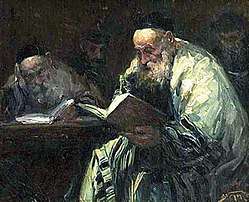Targum Jonathan
Targum Jonathan (Hebrew: תרגום יונתן בן עוזיאל), otherwise referred to as Targum Yonasan/Yonatan, is the official eastern (Babylonian) targum (Aramaic translation) to the Nevi'im.
| Rabbinic literature | ||||||||||||
|---|---|---|---|---|---|---|---|---|---|---|---|---|
 Talmud Readers by Adolf Behrman | ||||||||||||
| Talmudic literature | ||||||||||||
|
||||||||||||
| Halakhic Midrash | ||||||||||||
|
||||||||||||
| Aggadic Midrash | ||||||||||||
|
||||||||||||
| Targum | ||||||||||||
|
||||||||||||
It is not to be confused with Targum Pseudo-Jonathan, an Aramaic translation of the Torah, which is often known as "Targum Jonathan" due to a printer's error.
Origin
It originated, like Targum Onkelus, in the synagogue reading of a translation from the Prophets, together with the weekly lesson.
The Talmud[1] attributes its authorship to Jonathan ben Uzziel, a pupil of Hillel the Elder. According to this source, it was composed by Jonathan ben Uzziel "from the mouths of Haggai, Zechariah, and Malachi," implying that it was based on traditions derived from the last prophets. The additional statements that on this account the entire land of Israel was shaken and that a voice from heaven cried: "Who has revealed my secrets to the children of men?" are legendary reflections of the novelty of Jonathan's undertaking, and of the disapprobation which it evoked. The story adds that Jonathan wished to translate the Ketuvim also, but that a heavenly voice bade him desist. The Targum to Job, which was withdrawn from circulation by Gamaliel I, may have represented the result of his attempts to translate the Ketuvim.[2]
Jonathan ben Uzziel is named as Hillel's most prominent pupil,[3] and the reference to his Targum is at least of historical value, so there is nothing to controvert the assumption that it served as the foundation for the present Targum to the Prophets.[4]
It was thoroughly revised, however, before it was redacted in Babylonia. In the Babylonian Talmud it is quoted with especial frequency by Joseph, head of the Academy of Pumbedita,[5] who says, with reference to two Biblical passages,[6] "If there were no Targum to it we should not know the meaning of these verses".[7] This shows that as early as the beginning of the fourth century the Targum to the Prophets was recognized as of ancient authority.
Hai Gaon apparently regarded Joseph as the author, since he cited passages from it with the words "Rab Joseph has translated".[8]
Linguistic analysis
The language of Targum Jonathan is Aramaic. Its overall style is very similar to that of Targum Onkelos (to the Pentateuch), though at times it seems to be a looser paraphrase of the Biblical text.[9]
It is the result of a single redaction.[4]
Like Targum Onkelos, it gained general recognition in Babylonia in the third century; and from the Babylonian academies it was carried throughout the Diaspora. It originated, however, in the Land of Israel, and was then adapted to the vernacular of Babylonia; so that it contains the same linguistic peculiarities as the Targum Onḳelos, including sporadic instances of Persian words.[10] In cases where the Palestinian and Babylonian texts differ, this Targum follows the latter.[11]
Although Targum Jonathan was composed in antiquity (probably in the 2nd Century CE), it is now known only from medieval manuscripts, which contain many textual variants.[12]
Liturgical use
In Talmudic times (and to this day in Yemenite Jewish communities) Targum Jonathan was read as a verse-by-verse translation alternatively with the Hebrew verses of the haftarah in the synagogue. Thus, when the Talmud states that "a person should complete his portions of scripture along with the community, reading the scripture twice and the targum once",[13] the passage may be taken to refer to Targum Jonathan (as well as to Targum Onkelos on the Torah).
See also
References
- Megillah 3a
- see Bacher, "Ag. Tan." i. 23 et seq.; 2d ed., pp. 20 et seq.
- Sukkah 28a
- Jewish Encyclopedia, Targum
- see Bacher, "Ag. Bab. Amor." p. 103
- Isaiah 8:6 and Zechariah 12:11
- Sanhedrin 94b; Moed Kattan 28b; Megillah 3a
- Commentary on Ṭohorot, quoted in the "'Aruk"; see Kohut, "Aruch Completum," ii. 293a, 308a
- A. Shinan, "Dating Targum Pseudo- Jonathan: Some More Comments", JJS 61 (1990) 60 (57-61), comments, such a conclusion ...
- e.g., "enderun," Judges 15:1, 16:12; Joel 2:16; "dastaka" = "dastah," Judges 3:22
- "madinḥa'e"; see Pinsker, "Einleitung in die Babylonische Punktuation," p. 124
- Hector M. Patmore, The Transmission of Targum Jonathan in the West: A Study of Italian and Ashkenazi Manuscripts of the Targum to Samuel (Oxford University Press, 2015)
- Berakhot 8a-b
External links
- Original text
- English Translation of the Targumim at The Newsletter for Targumic and Cognate Studies
- CAL Targumic Studies Module